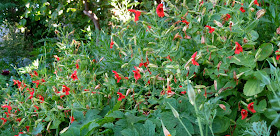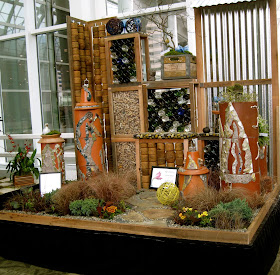I have three kinds of perennial monkey flower growing in my garden here in western Washington -- Mimulus cardinalis, Mimulus lewisii x cardinalis and Mimulus aurantiacus 'Apricot.' I started the Mimulus cardinalis from seed my very first winter in this house, using winter sowing methods, and planted it out in the spring. That spring I also sent in my very first order to Annie's Annuals, and part of that order was a single pot each of M. lewisii and M. aurantiacus.
Mimulus cardinalis
M. cardinalis, also called scarlet monkey flower, likes moist soil, so that first year I planted it near the front of one of my borders in the back garden, knowing it would get overspray in that spot from the lawn sprinklers. It stayed in that spot until this past late winter/early spring, when I started a complete overhaul of that bed. It had always been just a little too tall for that front spot, so I moved it into the center of the bed. It doesn't get overspray any more from the lawn sprinklers, which we now use a lot less often than we did when the lawn was new and had just been seeded. Those four tiny little cups of seedy hope have now turned into quite a nice swath of plants, which the hummingbirds just love.
 |
| The flowers look to me like a big red yawning mouth with buck teeth |
Some facts about scarlet monkey flower:
Height: 24-36 inches
Width: 18-24 inches
Soil Preference: Moist, rich soil
Hardiness: Zone 6-9
Sun exposure: Full sun to light shade
Native range: Western North America
Mimulus lewisii x cardinalis
My one little pot of
M. lewisii x cardinalis from Annie's has also turned into a swath of plants. I planted it near the M. cardinalis that first year, because it also likes moisture, and again, moved it into the center of the bed when I overhauled it. When I moved it, I divided it, spreading it into a wider space. The hummers love it as well. It's a naturally occurring hybrid of M. lewisii and M. cardinalis.
Some facts about M. lewisii x cardinalis:
Height: 18-24 inches (although mine is the same height as the scarlet)
Width: 24-36 inches
Soil Preference: Moist, rich soil
Hardiness: Zone 6-10
Sun Exposure: Full sun to light shade
Native range: Western North America
Mimulus aurantiacus 'Apricot'
My solitary pot of
M. aurantiacus from Annie's has turned into a good-size shrubby deciduous clump, but isn't really divide-able. Unlike its monkey relatives, it doesn't prefer moisture, so because it had peach-colored flowers, I planted it with others that I thought would make a good match -- Carex testacea, a peach-colored Primula (which doesn't actually bloom at the same time), Pennisetum 'Karley Rose' which right now has pretty much overwhelmed it completely by draping its puffy seedheads all over it), and some Euphorbias with chartreuse bracts, red stems and purple foliage. It starts flowering earlier in the spring than the other two monkey flowers. I've never seen the hummers feeding from it. I usually cut it back to the ground, but I think this coming winter I might leave it and see if its top growth survives. Its common name is Sticky Monkey Flower, because of the clinging nature of its leaves.
 |
| M. aurantiacus 'Apricot' soon after being planted |
Some facts about M. aurantiacus
Height: 24-36 inches
Width: 36 inches
Soil Preference: Adaptable, but prefers dry
Hardiness: Zone 7-10
Sun Exposure: Full sun to part shade
Native range: Western North America
I'm a couple of days late with this post, but hopefully Gail of clay and limestone will forgive me. I've been doing lots of little chores out in the garden, pausing every so often to document them with the camera, and then trying to gather my thoughts together to do several different posts. Too much going on at once!
Check out Wildflower Wednesday on clay and limestone, and be sure to visit all the other bloggers who are posting about wildflowers. Wildflower Wednesday is on the fourth Wednesday of every month and its purpose is to celebrate wildflowers all over the world.




























































